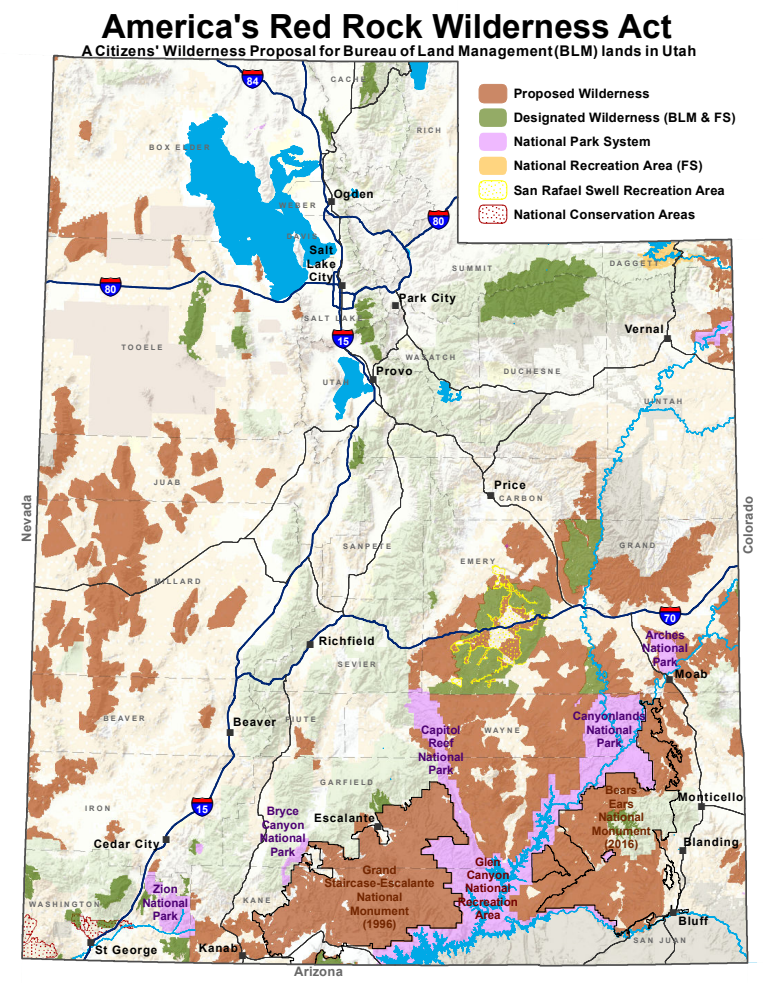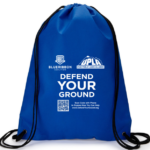SUWA is the Southern Utah Wilderness Alliance, a 501c3 charitable organization with offices in Salt Lake City, Moab, and Washington DC. Their stated “Mission of the Southern Utah Wilderness Alliance is the preservation of the outstanding wilderness at the heart of the Colorado Plateau, and the management of these lands in their natural state for the benefit of all Americans.”
To fulfill their mission to have more lands designated as Wilderness, Wilderness Study Areas, or Areas with Wilderness Character SUWA has used their army of attorneys to bring countless lawsuits against the BLM and other land managers. The threat of litigation has often pushed land managers into submission when evaluating new plans in favor of SUWA’s extreme environmental policy. Their single focused dedication to wilderness is serving only a narrow segment of Americans, while depriving the vast majority of Americans from enjoying our public lands.
SUWA has significant financial resources to gain ground through the courts, but they may have a big chink in their armor when it comes to Finances.. Their latest 990 Tax Return showed they had $25M in assets at the beginning of 2022, but only $22M at the end. In addition, they have unrealized losses of $3.2M in investments, that’s a decline of almost $6M in 2022 alone, a 25% decline. Compounding the issue with their balance sheet, their total revenue decreased in 2022 by almost 50%, yet expenses increased. The result was a net loss of $46,713 in 2022, compared to a profit of $4,743,299 the 2021.
SUWA brags about their Stewardship program that engaged 145 volunteers spending 2,437 volunteer hours during 2022. Sounds impressive until you consider the work hours and money that OHV groups expend improving and maintaining public lands. UPLA’s Sand Mountain Service project last year had 175 people over 2 days working almost 1,400 hours on just that one project. In Washington County alone, UPLA, Desert Roads and Trails Society, Tri State ATV Club, and St George Jeepers spent many more work days last year working on various projects including installing a second composting toilet and building a 5 acre staging area. Countless groups through Utah invested similar volunteer and financial resources on projects not only for OHV, but many other user groups as well.
We are good at doing the work, but we have not been great at getting the credit for it.
I’d like to share a story by Scott Groene, SUWA Executive Director, that is quite revealing about some of SUWA’s exaggerated claims about the pending doom caused by motorized traffic.
“Last summer, a massive flash flood blew through Mill Creek Canyon in southeast Utah, a place I often visit. Bursts of torrential rain filled the canyon with a temporary and raging river that hauled decades-old debris downstream, rearranging the canyon floor. Wandering the canyon afterwards, I was awed by how the flood uprooted or snapped mature trees, created new slickrock bowls where thickets of willow and tamarisk had stood, and washed out heavy brush to leave a parklike stand of tall cottonwoods rising over a floor of smooth bare sand. But I know that next spring, the undergrowth will return. The soils and plants will reestablish themselves where there is now only exposed and water-sculpted stone. The canyon will return to its former state”
I find it humorous that the epic devastation described will be restored in just a few months, yet they consistently complain that impacts caused by motorized vehicles will take many years, or never recover.
In a 2017 settlement of one of SUWA’s lawsuits against BLM, BLM agreed to revise or complete 13 new Travel Management Plans by 2025. The settlement requires BLM to expressly consider impacts to lands with wilderness character, sensitive natural resources, and cultural resources. The recent Labyrinth Rims/Gemini Bridges plan was disastrous to OHV and dispersed camping with 317 miles (30%) of roads and in excess of 120 dispersed campsites closed. Additional Utah Travel Plans to come include Book Cliffs, Dinosaur North, Dolores Triangle, Henry Mountains, Nine Mile, Pausaugunt, San Rafael Swell, and Trail Canyon.
While it is commonly known that SUWA declared war against OHV users 40 years ago, they have carefully hidden the story of the impact this will have on other users such as equestrians, rock climbers, canyoneers, hikers, campers, paragliding, base jumpers, rock hounders, photographers, hunters, fishermen, and river users, which will be outlined later.
To really understand SUWA’s actions, it is important to understand some concepts
Wilderness and Wilderness Study Areas can only be designated by an Act of Congress. An area with wilderness character can be designated by BLM, Forest Service, or National Monuments with the stroke of a pen by a mid level manager. Wilderness areas must be at least 5,000 acres in size, and have “naturalness” (where the imprints of human intrusion are “substantially unnoticeable”).
The area must be entirely roadless, no OHV, but also no highways through the area. The proposed Alternative D of the Grand Staircase National Monument would add 559,000 acres as Wilderness, and encompasses an area the size of the State of Delaware, yet allows on 5 roads to traverse the entire area.
The Red Rock Wilderness Act was originally introduced into Congress in 1989, and has been reintroduced every year since without passage. It will add 8 million acres of Wilderness to the 1.8 million currently existing in Utah, an increase of more than 500% 
Permitted Uses are non-motorized recreation including horseback riding, non-commercial herb gathering, hiking, camping, fishing, and hunting. Note that bicycles of all types are not allowed. What is not spoken of is that many of these allowed activities will be impacted because of the new difficulty getting near the area to recreate. A fisherman’s favorite fishing hole may be far less attractive if they have to hike 8 miles to get there. Equestrians will be faced with a much longer ride to get to their favorite areas because of the lack of roads and staging areas. These factors will also likely affect rock climbers, canyoneers, snowmobilers, hikers, campers, paragliding, base jumpers, rock hounders, photographers, hunters, and fishermen.
Prohibited uses include use of motorized vehicles in wilderness including trucks, cars, bulldozers, snowmobiles, off-road vehicles, helicopters, and other motorized equipment such as chain saws cannot be used within wilderness areas. Grazing is allowed only if the permit existed continuously prior to the designation of the area as a wilderness. Additional restrictions apply in other areas, in the Grand Staircase, grazing is currently not allowed on 125,000 acres, under Alternative D, it will not be allowed on 1,092,000 acres, a 50% reduction.
SUWA’s strategy seems to be well thought out, and it’s been effective at restricting access to public lands for many users, and as they work to expand the interpretation of FLPMA in new ways, they will continue to be one of our strongest foes. First, they eliminate roads of all types in an area, that is why there is a focus on eliminating duplicate roads to get an area to exceed that 5,000 acre target where it can be considered for wilderness designation. Next, they need to close campsites that are permanent in nature, this includes bear boxes and fire rings, and of course any campsite accessed by any type of road. Eliminating grazing, mining, and extraction of fossil fuels is next. After these are accomplished, they will have the area designated as having wilderness character, which requires BLM to manage it to prevent any disruption in that character.
The proposed BLM Landscape Health and Conservation Rule, which SUWA was a strong supporter of, will be the magic bullet to make these steps much easier to accomplish without Congressional action, including all of the following:
- The ability to sell Conservation Land Leases to almost anyone to manage land with the rules they establish, and for as long as it takes to achieve the stated goal of returning it to it’s natural intact landscape. They can also be used to “mitigate” other actions, very similar to the carbon offset rules currently used by major polluters to offset their actions. State and local governments are not eligible to purchase the leases, but foreign governments, corporations, and even a new publicly traded security known as a Natural Asset Corporation is being considered by the Securities and Exchange Commission.
- Direct that BLM must designate new ACECs-Area of Critical Environmental Concern. We already have 70 ACEC’s in Utah, but BLM is required under the rule to designate more, regardless of whether it is necessary. The Rule is intended to be perpetual, meaning that even after doubling that to 140 by 2030 or even 1000, they would still be required to designate more.
- Adding annual reporting requirements to BLM State Directors about their progress in establishing more ACECs is overly burdensome, and will become a great tool to terminate management that is not compliant with establishing more ACECs.
- Establishment of new terms such as the priority to preserve or restore “intact landscapes” without any clear definition of what that means.
- The requirement that decisions be based on “high quality science” will eliminate comments made without expensive science studies may be considered not substantive, which means they don’t have to address them under NEPA.
- Grazing will be seriously curtailed in many more areas, leading to concerns with our food supply and thus potential national security issues.
- Allows BLM to levee fees or taxes without Congressional approval, and under the terms of a lease, those NACs and foreign countries can set their own fees for use of the land.
- The Rule will have a disparate impact on those individuals impacted by the Americans with Disabilities act in emphasizing the priority of wilderness, even though only 3% of visitors are to wilderness areas.
Summary: Ben Burr, Executive Director of BlueRibbon Coalition, has said repeatedly, “we need to start acting as big as we are.” UPLA’s mission is to protect access for all responsible users, not just a privileged few. All the various users using our public lands may have slightly different beliefs, but we should all join together in fighting for access for everyone and stop the divide and conquer philosophy that detracts from our collective power.
Here are some critical steps you can take to make a difference:
- Take the time to understand land actions and make substantive comments on them. Under FLPMA, if a comment is not made during the open comments period, you do not have standing to bring an action in court. Comments by all users are one of the most important steps you can take as an individual in preserving our joint access. UPLA is organizing a Comments Training Workshop in Salt Lake City the day before SLOREX opens (February 29). Watch for more details and sign up to attend.
- Join groups such as UPLA that fight for access for all users, and when able donate to them to fight for you.
- Share news to others about actions of concern, and plead for your friends to take action. If you see a post or article of interest, share it with your friends.
- Organize or participate with local groups to enhance and protect resources on public lands. Consider stepping out of your particular recreation field and work on other projects of importance to others. Cleanups or repairs are generally welcomed and supported by Land Managers, contact them for approval and assistance. The Utah Department of Natural Resources has a fantastic Grants program that can provide both money and volunteer resources to complete projects in your area.
- Take the Credit! When scheduling a project, be sure to notify your local media about the event with a Press Release. After the event is over, send them photos and a report about how many participated, what was accomplished, and if you know what your next project will be. Email that information to UPLA so we can use it when we need it.
- Don’t Give Up! SUWA is clearly one of our most potent enemies and they are emboldened by our current political climate, we must start to ACT AS BIG AS WE ARE.
Together We Can Win,
But We Can’t Do It Without You!
Loren Campbell
Sources and References:
SUWA 2022 Annual Report
SUWA 2022 Tax Return
BLM Landscape Health and Conservation Rule-UPLA Comments
BLM Landscape Health and Conservation Rule-UPLA link to Rule and Concerns


 Artec Industries is donating $10,000 in Gift Cards for entries in our Sweepstakes During Winter 4×4 Jamboree. You’ll be entered to win up to $10,000 in Artec Gift Cards as Flash Prizes during Winter 4×4 Jamboree, plus chances to win a $30,000 Dream Build on your Rig in the Grand Sweepstakes.
Artec Industries is donating $10,000 in Gift Cards for entries in our Sweepstakes During Winter 4×4 Jamboree. You’ll be entered to win up to $10,000 in Artec Gift Cards as Flash Prizes during Winter 4×4 Jamboree, plus chances to win a $30,000 Dream Build on your Rig in the Grand Sweepstakes.